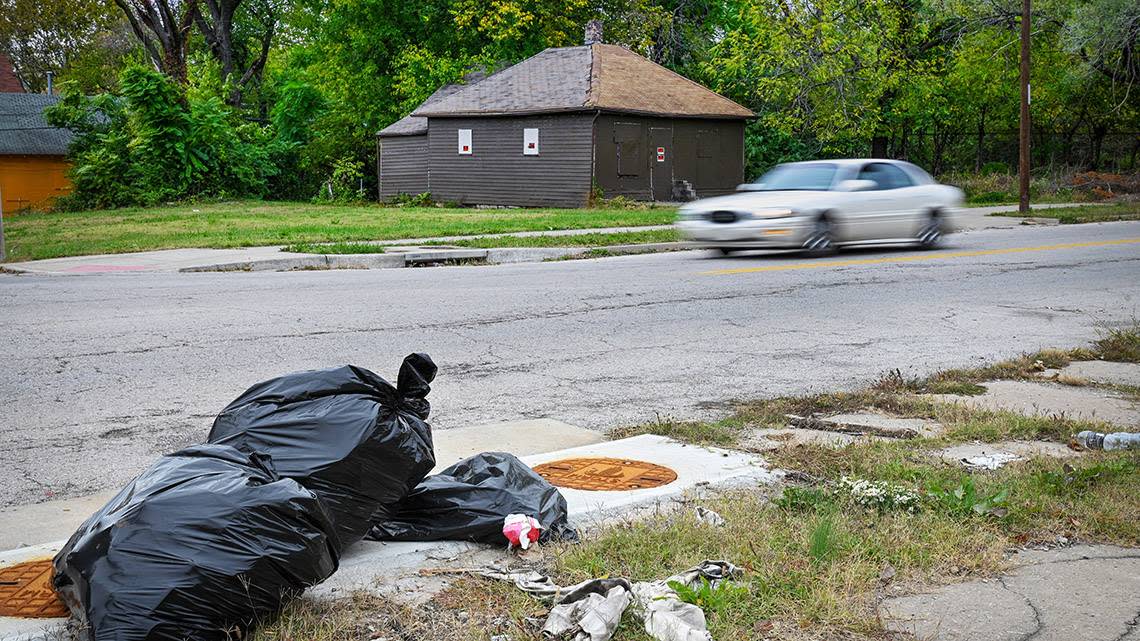Blight leads to violent crime. Why doesn’t Kansas City solve both problems at once? | Opinion

Long ago, I took advantage of the Kansas City Police Department’s ride-along program after a shooting three blocks from my home.
What I most remember is the trash. Officers showed me run-down neighborhoods with vacant and collapsing houses, piles of trash neglected for weeks and discarded furniture along the streets. It’s tough to care about your community, the officers told me, when no one else does.
Years later, in 2016, then Kansas City Police Chief Darryl Forté wrote in his blog that neighborhoods with low levels of violent crime have, among other things, more occupied homes, working streetlights and minimal trash: “There is a sense of pride and ownership in those neighborhoods. People look out for one another. At recent homicide scenes, I’ve seen trash everywhere, overgrown brush, blighted vacant houses, busted sidewalks and more.” Two weeks later, Kansas City PBS aired “Our Divided City,” a documentary highlighting the impact of blighted properties on crime and poverty.
Have things gotten any better in the years since? Forest Tyson doesn’t think so.
Tyson, vice president of the Oak Park Neighborhood Association’s 7,000 homes, said “the city has taken the position that they’re waiting for developers to come and do the work.”
It’s a national issue. In 2019, the Manhattan Institute published an essay, “Cleaning Up Vacant Lots Can Curb Urban Crime,” that identified the same issues Forté did, pointing to a successful anti-blight program in Philadelphia. At the time of the article, the Philadelphia LandCare program, initiated in 1996, had transformed more than 13,000 vacant lots across the city, partnering with local contractors and city agencies. The scalable model improved more than 18 million square feet of land, a model for other cities.
It turns out that reducing blight reduces crime. In a citywide experiment, the LandCare program was found shootings reduced by 8% and nuisance crimes reduce by 7% around remediated lots. In neighborhoods below the poverty line, these effects were even more pronounced, with a 29% reduction in gun assaults.
Residents nearby reported feeling safer and more likely to use outdoor spaces for relaxing and social activities, contributing to a sense of community well-being. More than half of the residents surveyed experienced fewer security concerns when leaving their homes, and more than three-quarters indicated increased outdoor activity.
Beyond crime reduction, study indicates the program provided economic opportunities by employing local residents for lot maintenance, fostering community engagement and improving social infrastructure. Additionally, improved perceptions of safety and reduced stress contribute to better health outcomes, reducing chronic stress and health disparities in low-resource neighborhoods.
Every element of that program could be copied in Kansas City. Why aren’t we?
Portland, Oregon, undertook a similar effort in 2021 to reduce shootings by two-thirds by using traffic-calming orange traffic barrels, enhanced street lighting and park patrols. Gun violence rates remained constant in the rest of the city. The pilot program ran for just two months, and while it’s not enough to draw conclusions, the results were promising.
An entertaining six-minute video released in 2022 by Kite & Key Media called “Less Crime, By Design” outlines some of the successes in Philadelphia and elsewhere of reducing crime by addressing blight.
Unfortunately, too many leaders want to talk about guns when asked about violent crime. That’s a dodge. Forté’s 2016 blog post anticipated as much: “Without a doubt, guns have always been the leading cause of violent death in Kansas City. But guns are just a small piece of the issue.”
The policies aren’t particularly flashy, but they work. Cities can deliver basic services such as trash removal and maintain city property — especially city-owned vacant lots and abandoned houses. Getting police officers out of their cars and walking the beat, as was done in the 1990s, would help, too. And when people want to invest in neighborhoods by building homes, cities should do what they can to remove barriers and reduce costs.
City officials can do plenty to alleviate crime and persistent poverty. We should demand they do so.
Patrick Tuohey is co-founder of Better Cities Project, a 501(c)(3) nonprofit focused on municipal policy solutions, and a senior fellow at the Show-Me Institute, a 501(c)(3) nonprofit dedicated to Missouri state policy work.


